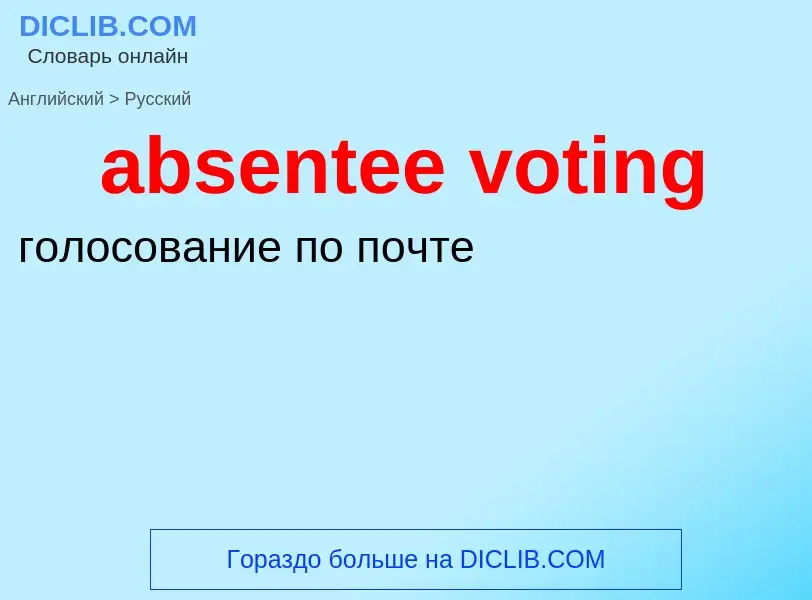Traducción y análisis de palabras por inteligencia artificial ChatGPT
En esta página puede obtener un análisis detallado de una palabra o frase, producido utilizando la mejor tecnología de inteligencia artificial hasta la fecha:
- cómo se usa la palabra
- frecuencia de uso
- se utiliza con más frecuencia en el habla oral o escrita
- opciones de traducción
- ejemplos de uso (varias frases con traducción)
- etimología
absentee voting - traducción al ruso
[æbs(ə)n'ti:'vəutə]
общая лексика
голосующий заочно (по почте)
Definición
Wikipedia
An absentee ballot is a vote cast by someone who is unable or unwilling to attend the official polling station to which the voter is normally allocated. Methods include voting at a different location, postal voting, proxy voting and online voting. Increasing the ease of access to absentee ballots is seen by many as one way to improve voter turnout through convenience voting, though some countries require that a valid reason, such as infirmity or travel, be given before a voter can participate in an absentee ballot. Early voting overlaps with absentee voting. Early voting includes votes cast before the official election day(s), by mail, online or in-person at voting centers which are open for the purpose. Some places call early in-person voting a form of "absentee" voting, since voters are absent from the polling place on election day.
In the electoral terminology of some countries, such as Australia, "absentee voting" means specifically a vote cast at a different polling station to one to which the voter has been allocated. "Early voting", "proxy voting" or "postal voting" are separate concepts in these countries. The history of absentee voting dates back to the 19th century, and modern-day procedures and availability vary by jurisdiction. Absentee voting may be available on demand, or limited to individuals meeting certain criteria, such as a proven inability to travel to a designated polling place. Many electors are required to apply for absentee voting, although some may receive a postal ballot by default. In some elections postal voting is the only voting method allowed and is referred to as all-postal voting. Typically, postal votes must be mailed back on or before the scheduled election day. However, in some jurisdictions return methods may allow for dropping off the ballot in person via secure drop boxes or at voting centers.
Electoral laws typically allow for the integrity and secrecy of the submitted ballot to be maintained, and stipulate a series of checks to protect against voter fraud. Voting at a distant polling place is subject to the same controls as voting locally, though distant staff are less likely to recognize an impersonator than local staff. Voting by mail is sometimes controlled by using security printing, such as special paper, or by requiring signatures of voters and sometimes witnesses, though signature comparisons have 10-14% error rates. Thousands of ballots fail these checks and are rejected. Evidence of fraud is uncommon. While postal voting has a greater risk of fraud than in-person voting, on an absolute level cases of known fraud are extremely rare.

![Postal voting documents sent to an Indonesian voter in the United Kingdom during the [[2019 Indonesian general election]]. Postal voting documents sent to an Indonesian voter in the United Kingdom during the [[2019 Indonesian general election]].](https://commons.wikimedia.org/wiki/Special:FilePath/Indonesian abroad postal voting package (2019).jpg?width=200)
![Electoral package sent to an Italian voter in South America during the [[2013 Italian general election]]. Electoral package sent to an Italian voter in South America during the [[2013 Italian general election]].](https://commons.wikimedia.org/wiki/Special:FilePath/Plico elettorale Italia 2013.jpg?width=200)
